For PDF version of this newsletter, please click here:
Welcome to our Fall 2023 newsletter, the “POST FIRE EVACUATION” edition! It’s been a tumultuous couple of weeks in Yellowknife as we dealt with a major forest fire on the edge of the city, and a three week city-wide evacuation. We hope everybody in Yellowknife is now happily settled back into their homes after the adventure we all experienced. We are very happy that the forest fires did not get out of control and that Yellowknife was safe - thanks to the many people that stayed behind to safeguard the community.
A special thank you to the members who responded to our emergency call to clear some brush around the museum buildings on August 16, the night of the evacuation order: Diane Baldwin, Walt Humphries, Pamela Taylor, Brian Latham, Dingeman van Bochove, Lex Lovatt, Patti Beales, and Ryan Silke.
Another special thank you to Ben Nind, who stayed behind during the evacuation to help with logistics, and also acted as watchman at Giant Mine.
MUSEUM CONSTRUCTION
Needless to say, our big plans for project completion this fall has been delayed. Construction of exhibits continued throughout the summer with a special focus on dioramas. Three dioramas were built using materials salvaged from various old buildings over the years. The dioramas are a Mine Office, a Machine Shop, and a Trading Post and are fully-furnished with authentic old artifacts.
Steve Freake (“Design Freake”) was hired to work on various exhibit panels, and Janet Pacey’s Signed Ltd was commissioned to print the panels. Signed provided a significant discount as a sponsor. Thanks Janet! Alison McCreesh and Ryan Silke worked on a large illustration of Yellowknife in the 1950s which will hang in the main exhibit hall. Other panels worked on were the Museum Introduction, Timeline, and panels about the Yellowknives Dene history and the story of how Yellowknife got its name.
Thank you Conrad Shubert and Klaus Scheuhing for helping Ryan move some heavy furniture recently.
FUNDING
More operating grants have been received from the Government of the NWT: Education, Culture and Employment to the tune of $135,000. Additional funding has been asked of Canadian Heritage which we expect to receive soon.
Sneak peak of Alison McCreesh’s map of Yellowknife in the old days:
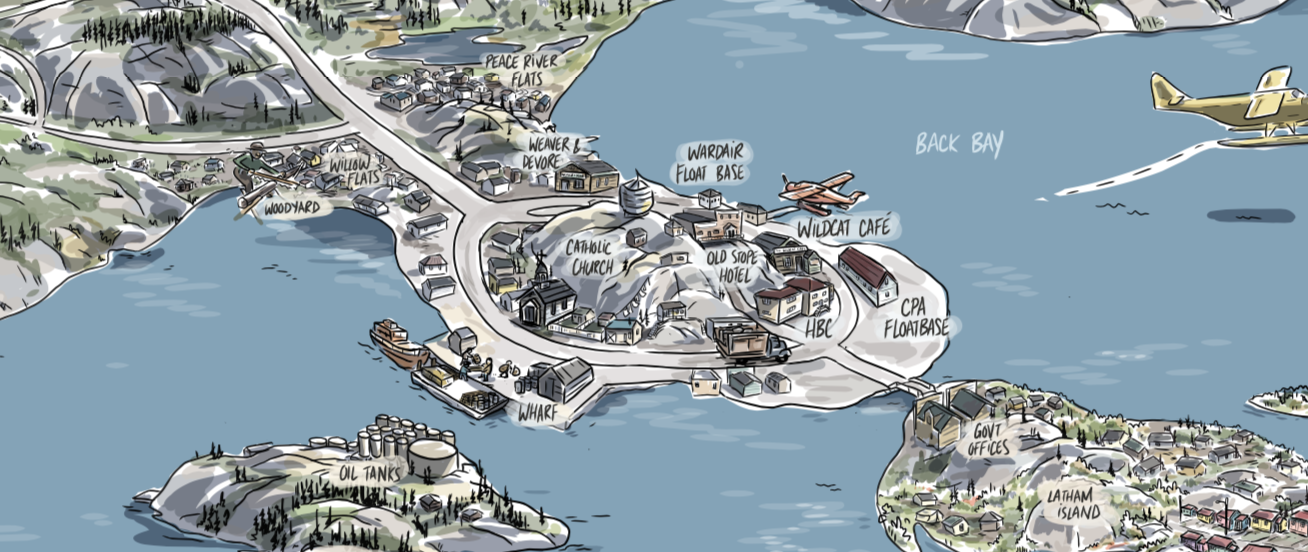
Helmut Epp, Niels Weiss, and Ryan Silke worked on Cat Train caboose repairs. Roll-roofing for new siding was paid for with our GNWT ECE grant last year:
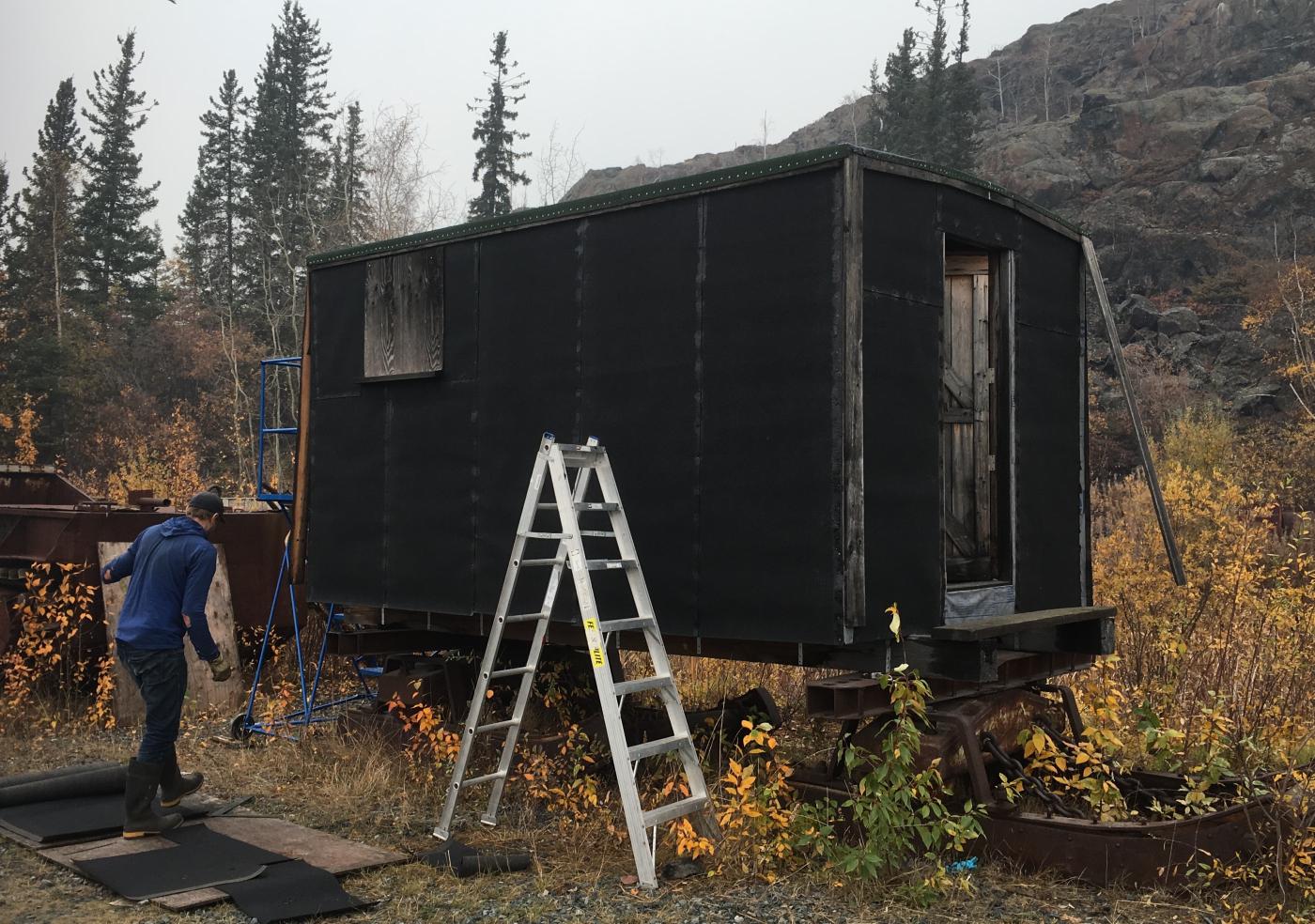
DONATIONS
We received a $2,000 donation via the Raymond James Foundation, from Simon & Lenore deJong, long-time Yellowknifers. Thank you to the deJongs!
Yvonne Quick kindly donated deck umbrellas for use on our outdoor patio and 40 stackable chairs for inside use.
Diane Baldwin connected with Alice Payne in Calgary while she was evacuated. It was nice to see Alice - a major financial contributor to our museum project. Alice donated a claim post that her father, Tom Payne, staked during his time in Yellowknife. Thank you, Alice! (seen below)
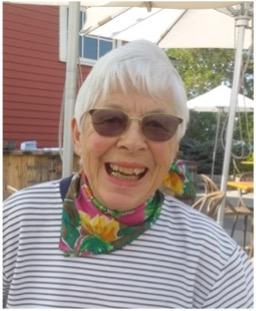
Gord Piro donated several items from his family’s collection, including various décor formally used in The Prospector Restaurant which his family operated in Old Town in the 1990s. The artfully-painted pots, pans, saws, and cans are colorful additions to our artifact display shelves in the Gift Shop and Restaurant and other places. Yellowknife artist Brian Macdonald painted the artifacts.
HAPPY BIRTHDAY WALT HUMPHRIES!
Walt Humphries celebrated his 75th birthday on September 28! We were even able to personally give me a ‘happy birthday’ song during our evening work party at the rec hall. Walt is, of course, former president of the Society and provided the initial spark to build a museum at Giant Mine. He is very happy to see our dreams finally becoming a reality, only 23 years after we first embarked on this mission!
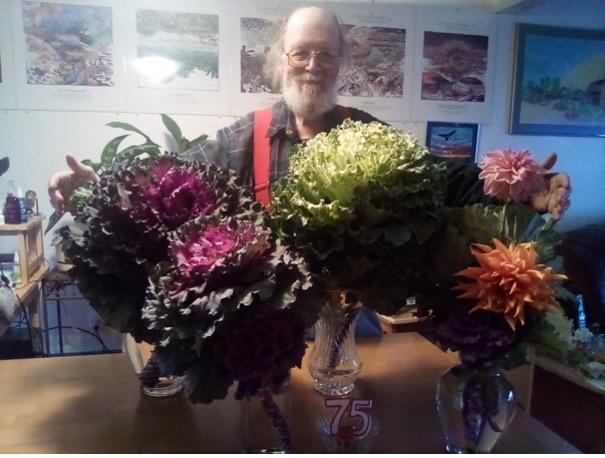
Thank you to all the volunteers who came out for our work party to give the building a clean sweep: Walt Humphries, Diane Baldwin, Ryan Silke, Helmut Epp, Bruce Davidson, Marie Adams, Conrad Schubert, Pamela Taylor, Bill Braden, Karen Gochnauer, Brian Latham, Klaus Scheuhing, and Meta Antolin.
THE BUSH FIRES OF THE 1930s
Wildfires are not new to Yellowknife. The city experienced bad fire seasons in recent memory to many of us: 1998, and of course, the summer of smoke, 2014. This past summer, 2023, proved to be a very memorable one too. But Yellowknifers have co-existed with fire since the beginning of the community.
Bush fires plagued Yellowknife during the height of the gold rush in the late 1930s. In July 1936, a fire was started near Duck Lake on the east side of Yellowknife Bay. Fanned by strong south winds, the fire crept up the Bay towards Burwash Point, where the Burwash gold mine was operating. The miners abandoned their gold workings and battled the flames with pick axe and shovel to clear a fire break. The fire also threatened the nearby Dene village of Dettah, where all the men of the community had left to accept Treaty money in Fort Resolution. Women of the village kept regular vigil to stamp out embers as they fell amongst their skin lodges and log cabins. (Not surprising that Dettah means “burnt point.”) A shift of wind ultimately saved the day.
In 1938, the town of Yellowknife was booming, when a smoky haze blew in from the southwest. A massive forest fire was burning up from the North Arm of Great Slave Lake towards the Con and Negus gold mines. Dry weather and high winds fanned the flames. All of the land around Kam Lake was a blaze. The miners saved their camp, but the next summer, 1939, new hot spots popped up around today’s Tin Can Hill where a telephone line strung between the mines and Old Town was at great peril. At Peace River Flats, a smoldering fire encroached towards residences and burned down a cabin before a group of citizens responded to save Old Town.
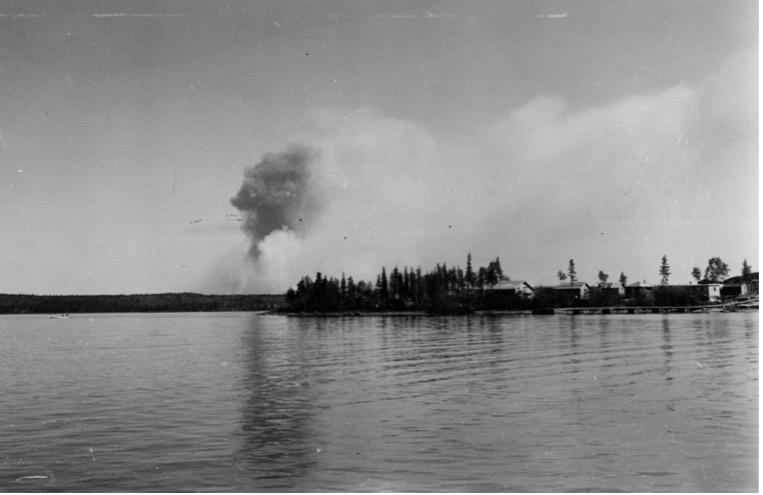
Forest fires across Yellowknife Bay in the 1930s (YK Historical Society collection)
Debate raged for years about the root cause of wildfires. Some believed it was the result of careless campers and hunters failing to extinguish their campfires. Others blamed prospectors for igniting the bush to eliminate moss and overburden to make their job of searching for minerals easier. One of the more interesting theories suggested pilots were throwing cigarette butts from their floatplanes.
Yellowknife was spared of wildfire in the 1930s and again in 1945 when fires raged once more throughout the region. It is no surprise that fires have returned in 2023. Our forests have been allowed to grow thick with deadfall, as there has not been a fire in this area in 75 to 85 years!
Yellowknife Historical Society
Box 1856 Yellowknife NT X1A 2P4
www.yellowknifehistory.com info@yellowknifehistory.com
Newsletter edited by Ryan Silke

ALICE PAYNE